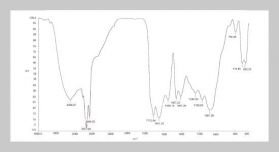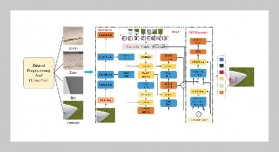Xin Guan , Haoran Xu, Chenhao Zhao, Yu Hua, and Zhe Wang
Shenyang Institute of Engineering, Shenyang, Liaoning, 110136
Received:
September 16, 2024
Accepted:
October 29, 2024
Publication Date:
December 7, 2024
Copyright The Author(s). This is an open access article distributed under the terms of the Creative Commons Attribution License (CC BY 4.0), which permits unrestricted use, distribution, and reproduction in any medium, provided the original author and source are cited.
Download Citation: ||https://doi.org/10.6180/jase.202509_28(9).0005
In order to improve the operational stability of wind turbines and optimize power quality, this paper studies the blade root load and power output of wind turbines under actual working conditions from the perspective of pitch control. The calculation method of load is simplified by Coleman coordinate transformation, and the variable universe fuzzy control rule of blade load control is established. The blade root load and power output of wind turbine under three control modes of unified pitch control, d-q PID control and power load cooperative control are calculated. The results show that compared with the other two control methods, the variable universe fuzzy power-load coordinated control method has more advantages in reducing the blade root flapping torque and shimmy torque, improving the response speed, and suppressing the power output f luctuation. Especially in reducing blade root bending moment, the overshoot has decreased by 17% compared to unified pitch control.Therefore,the variable universe fuzzy PID coordinated control method is of great significance in improving the resistance to external disturbances and optimizing the output power during the operation of wind turbines.
Keywords:
windturbine; variableuniverse theory; power-load coordinated control; Coleman transform; pitch control
- [1] A. J. Muñoz-Vázquez, V. Parra-Vega, A. Sánchez Orta, G. Romero-Galván, and D. Lara-Alabazares, (2020) “Robust control of wind turbines based on frac tional nonlinear disturbance observer" Asian Journal of Control 22(5): 1801–1810. DOI: 10.1002/asjc.2067.
- [2] B. Han, L. Zhou, F. Yang, and Z. Xiang, (2016) “In dividual pitch controller based on fuzzy logic control for wind turbine load mitigation" IET Renewable Power Generation 10: 687–693. DOI: 10.1049/iet-rpg.2015.0320.
- [3] Y. KONGandZ.WANG,(2008)“Designand Simula tion of Fuzzy Sliding Mode Robust Controller for Large Wind Turbine" Proceedings of the CSEE 28: 136–141. DOI: 10.13334/j.0258-8013.pcsee.2008.14.025.
- [4] G. Banjac, V. Spudic, and M. Baotic, (2013) “Tuning of model predictive controller for wind turbine load reduc tion" 2013 36th International Convention on Infor mation and Communication Technology, Electron ics and Microelectronics (MIPRO): 919–924.
- [5] Z. Civelek, M. Lüy, E. Çam, and H. Mamur, (2017) “A New Fuzzy Logic Proportional Controller Approach Applied to Individual Pitch Angle for Wind Turbine Load Mitigation" Renewable Energy 111: 708–717. DOI: 10.1016/j.renene.2017.04.064.
- [6] P. Ali, C. Mohammad, and B. Abbas, (2023) “Nonlin ear analysis of gain scheduled controllers for the NREL 5-MWturbine blade pitch control system" International Journal of Electrical Power and Energy Systems 145: 0142–0615. DOI: 10.1016/j.ijepes.2022.108578.
- [7] S. CAO, W. HAO,X. CHEN,F. WANG,H.WANG, and Z. SUN, (2019) “Load control of wind turbine based on Model Predictive Control" Journal of Suzhou Uni versity of Science and Technology 36: 79–84. DOI: 10.12084/j.issn.2096-3289.2019.03.014.
- [8] X. SUN,D.XIANG,W.DING,andK.ZHAO,(2023) “Research on independent variable pitch control of wind turbine based on Sparrow Search algorithm" Acta Ener giae Solaris Sinica 44: 266–274. DOI: 10.19912/j.0254-0096.tynxb.2022-0817.
- [9] S. Tang, D. Tian, X. Wu, M. Huang, and Y. Deng, (2022) “Wind Turbine Load Reduction Based on 2DoF Robust Individual Pitch Control" Renewable Energy 186: 28–40. DOI: 10.1016/j.renene.2021.10.086.
- [10] X. SUNandP.ZHOU,(2023)“Enhanced PID control method based on unknown state estimation and neural network compensation" SCIENTIA SINICA Informa tionis 53: 715–736. DOI: 10.1360/SSI-2022-0084.
- [11] Y. Yuan and J. Tang, (2017) “Adaptive pitch control of wind turbine for load mitigation under structural uncer tainties" Renewable Energy 105: 483–494. DOI: 10.1016/j.renene.2016.12.068.
- [12] Y. Zhang, Z. Chen, and M. Cheng, (2013) “Propor tional resonant individual pitch control for mitigation of wind turbines loads" IET Renewable Power Genera tion 7: 191–200. DOI: 10.1049/iet-rpg.2012.0282.
- [13] E.Bossanyi,B.Savini,M.Iribas,M.Hau,B.Fischer,D. Schlipf, T. Engelen, M. Rossetti, and C. E. Carcangiu, (2012) “Advanced controller research for multi-MW wind turbines in the UPWINDproject" WindEnergy15:119 145. DOI: 10.1002/we.523.
- [14] M. A. Lackner, (2013) “An investigation of variable power collective pitch control for load mitigation of float ing offshore wind turbines" Wind Energy 16: 519–528. DOI: 10.1002/we.1502.
- [15] T. Shize, T. De, F. Jianju, L. Feng, and Z. Chenkai, (2021) “Individual pitch controller characteristics analysis and optimization under aerodynamic imbalanced loads of wind turbines" Energy Reports 7: 6489–6500. DOI: 10.1016/j.egyr.2021.09.114.
- [16] T. L. Van, T. H. Nguyen, and D.-C. Lee, (2015) “Ad vanced Pitch Angle Control Based on Fuzzy Logic for Variable-Speed Wind Turbine Systems" IEEE Transac tions on Energy Conversion 30: 578–587. DOI: 10.1109/tec.2014.2379293.
- [17] V.Galdi,A.Piccolo,andP.Siano,(2008)“Designingan Adaptive Fuzzy Controller for Maximum Wind Energy Extraction" IEEE Transactions on Energy Conver sion 23: 559–569. DOI: 10.1109/tec.2007.914164.
- [18] A. Iqbal, D. Ying, A. Saleem, M. A. Hayat, and K. Mehmood, (2020) “Efficacious pitch angle control of variable-speed wind turbine using fuzzy based predictive controller" Energy Reports 6: 423–427. DOI: 10.1016/j.egyr.2019.11.097.
- [19] H. Bevrani and P. R. Daneshmand, (2012) “Fuzzy Logic-Based Load-Frequency Control Concerning High Penetration of Wind Turbines" IEEE Systems Journal 6: 173–180. DOI: 10.1109/jsyst.2011.2163028.
















